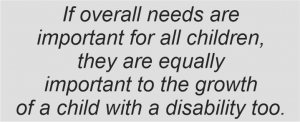Inclusion, it’s not for everyone?
By Colleen Tomko
Is a sense of belonging, meaning, and purpose, or happiness for everyone? Is the foundation of our country, the pursuit of life, liberty, and justice for “some”? If inclusion isn’t for everyone, is exclusion for some? Who decides who is to be excluded and on what basis, religion, race, sex, skin color, beliefs, abilities?
![]()
Before a statement is made about whether or not inclusion is for everyone, there must be a clear definition of what inclusion is.
In education, the word inclusion sometimes is used to simply describe a child with a disability placed in a regular class. Could this really be a definition of inclusion? Is every child in the regular class with or without a disability considered “included” just because they are there? Are there no requirements of being an active participant or being considered as a member who belongs? If you sit in the room you are included?
In general, when people describe being included they use words such as happy, accepted, welcomed, friendship, love, valued, and togetherness. When people describe being excluded, they use words like, isolated, lonely, dejected, angry, sad, abandoned, and depressed.
 Since the general thought is that inclusion makes people feel good, then why wouldn’t it be for everyone? A goal of education is to help children reach their potential and become productive members of society. When people feel good, they have a greater capacity to function to their potential in every aspect of their lives. There are sports, clubs, assemblies, and other non-academic activities that help children become well-rounded and more receptive to learning. If overall needs are important for all children, they are equally important to the growth of a child with a disability too.
Since the general thought is that inclusion makes people feel good, then why wouldn’t it be for everyone? A goal of education is to help children reach their potential and become productive members of society. When people feel good, they have a greater capacity to function to their potential in every aspect of their lives. There are sports, clubs, assemblies, and other non-academic activities that help children become well-rounded and more receptive to learning. If overall needs are important for all children, they are equally important to the growth of a child with a disability too.
If a child happens to have a disability he or she is still first and foremost a child. That child has the same basic needs of health and physical fitness; social and a sense of belonging; mental challenges and stimulation; spiritual and a sense of meaning and purpose, as any other child. When all these needs are met in an integrated way, a child can function better in every area of his or her life. Unmet needs affect the child’s overall well-being and his or her potential to function and learn.
Meeting all of a child’s needs should not be conditional upon placement. Being physically placed in the regular class should never mean that any needs are sacrificed. Additional needs can be met that can not be met in an excluded setting.

Our definition of inclusion in education is “the act of attending regular education classes, with the supports and services needed to successfully achieve the individual’s IEP goals, while actively participating in activities as a member of the class who belongs.” We believe inclusion is the desired state to be achieved, that may or may not occur by simple placement alone. It is an ongoing process. I believe that unless a child has a sense of identity with the class, and unless he or she has the supports and services needed and is reaching his or her IEP goals then inclusion has not been achieved. Yes, this does define inclusion only in the terms of success, but we truly believe that inclusion only means success. With that definition in mind, who is inclusion not for?
This material may be copied for non-profit use only. (It may be linked but not copied on to other websites)
Please notify us of your intentions.
